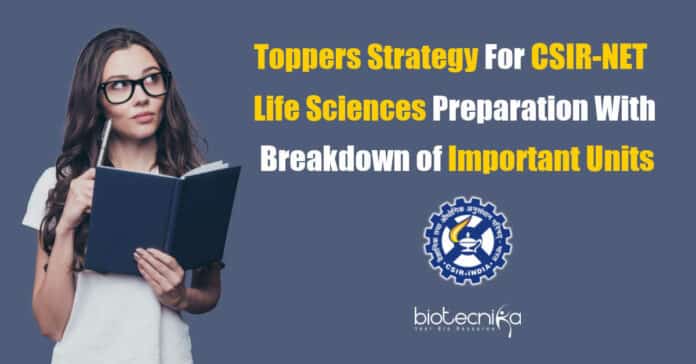CSIR-NET Life Sciences Preparation – A Unit-wise Strategy
The CSIR-NET exam is among the most coveted competitive exams in India. Therefore, its importance and precedence in the lives of Life Sciences students cannot be exaggerated. Students who aspire to become a lecturer or pursue research with a CSIR fellowship compete in qualifying for the exam.
The most challenging feature is the enormity of the syllabus. Life Sciences currently focus not only on zoology and botany but comprises an entire cornucopia of subjects, including biotechnology (a most popular one), microbiology, biochemistry, biophysical, biomedical engineering, genetics, genetic engineering, bioinformatics, etc. The CSIR-NET life sciences exam seeks to test the basic biology knowledge of students in nearly all these branches. Thus, every unit in the syllabus can be deemed necessary. However, students can skip 3-4 units that they are unfamiliar or disinterested in. Let us now see the unit-wise strategy for CSIR-NET exams.
Here is a link to the detailed syllabus provided by the CSIR-NET website – PDF link
Unit 1 – Molecules And Their Interaction Relevant To Biology
This unit comprises 2 sub-units – Biochemistry and Structural Biology.
- Important topics in biochemistry for CSIR-NET preparation include enzymology and metabolic pathways.
- The study of metabolic pathways requires a thorough and clear understanding of every step of the pathway in the right order, reasons for the sequence of the pathway, reactions involved, enzymes and coenzymes that bring about the reactions, etc.
- Enzymology has concepts such as the calculation of KM and enzyme inhibition which cannot be overlooked.
- Proteins are a vital topic here. Starting from the structure, nature, and side groups of amino acids, the sub-unit also covers Ramachandran’s plot, one of the favorites in the CSIR-NET question paper.
- Another important concept to grasp is the possibility of replacing one side group in an amino acid with another and the resultant biomolecule. Carbohydrates and the optical activity of amino acids are also important.
Books for unit 1 are:
- Lehninger Principles of Biochemistry by Albert L. Lehninger, David L. Nelson, and Micheal M. Fox
- Biochemistry by Donald Voet and Judith G. Voet
- Lubert Stryer’s Biochemistry Hardcover
- Trevor Palmer’s ENZYMES: Biochemistry, Biotechnology, Clinical Chemistry
Unit 2 – Cellular Organization
This unit deals with cell biology and is deemed essential for CSIR-NET Life Sciences Preparation.
- RBC membrane components such as transposons, FRAP, Lipid rafts, and Band 3are important topics from which questions are directed.
- Cell cycle and its regulation, along with the role of p53, are essential topics from which CSIR-NET questions are asked frequently.
- Besides, questions from anaphase-promoting complex, meiosis, mitosis are also frequently asked. So you should be very clear about what is happening in anaphase 1 and what is happening in anaphase 2, where the ploidy is changing and where it is not.
- Intracellular vesicle traffic is also significant, like the vesicle in which it occurs, where those vesicles, COP1, and COP2 are directed, etc.
- Also, questions are asked on caveolin-mediated transport and clathrin-mediated transport.
- Sums based on membrane transport can be asked, so it is an important topic too.
Books for Unit 2 are:
- Molecular Biology of the Cell by Bruce Alberts, Alexander Johnson, Julian Lewis
- Prescott’s Microbiology by Joanne Willey, Linda Sherwood, Chris Woolverton
- Gerald Karp’s Cell and Molecular Biology: Concepts and Experiments
Unit 3 – Fundamental Processes
This unit is all about molecular biology, mainly involving replication, transcription, and translation.
- All the processes belonging to the central dogma of molecular biology (replication, transcription, translation) are important.
- Factors involved in these processes include the location of TF2D and TF2H and energy details such as the amount of energy consumption, GDP-GTP ratio, place of GTP consumption, etc.
- Operons form a crucial concept that should be studied thoroughly and RNA processing and details about mRNA, rRNA, and tRNA.
- Inhibitors are generally asked to match the following type of questions. At least 15-20 drugs need to be learned.
Books for Unit 3:
- James D. Watson’s Molecular Biology of the Gene
- Benjamin Lewin’s Genes
Unit 4 – Cell Communication And Cell Signalling
This unit is about cell communication and immunology and is one of the most important units for CSIR-NET Life Sciences Preparation.
- A thorough study of cell biology would be the perfect prerequisite for learning about cell communication.
- Cell signalling involves studying the Wnt pathway, hedgehog pathway, and notch pathway. Pay close attention to these as questions have repeatedly been asked on these topics, and they also help understand developmental biology.
- Cancer biology is also an important topic, along with the role of tumour suppressor genes, oncogenes, B27, and p53.
- Immunology is an extremely detailed topic in standard books such as Kuby Immunology. You may refer to other books such as those from Biotecnika to get a clear and precise idea about the topic. Related important topics are extracellular matrix and cell adhesion molecules.
Books for Unit 4:
- Molecular Biology of the Cell by Bruce Alberts, Alexander Johnson, Julian Lewis
- Thomas J. Kindt’s Kuby Immunology
Unit 5 – Developmental Biology
Developmental biology studies are greatly benefitted from being clear about the earlier units of cell and molecular biology during your CSIR-NET Life Sciences Preparation.
- Cleavage patterns are an important topic here upon which the question paper generally contains direct questions that are conceptual and easy to answer.
- Yolk distribution pattern, polyspermy, prevention of polyspermy, vulva development, and access development of drosophila are often asked in the CSIR-NET exam. Studying developmental biology may be daunting with many topics but very important for those planning to score in animal physiology.
Books for Unit 5 are:
- Principles of Development by Lewis Wolpert, Cheryll Tickle
- Scott F. Gilbert’s Developmental Biology
Unit 6 – System Physiology – Plant
Plant physiology is a vast unit that focuses on the botany-based concepts of life sciences. Zoology students may skip this unit but keep in mind that this is also the unit with the maximum marks weightage in the CSIR-NET paper.
- Knowledge of metabolism and biochemical and metabolic pathways is a great help in studying this unit.
- A thorough study of photosynthesis involving the C2, C3, C4, and CAM pathways, oxidative phosphorylation, photophosphorylation (cyclic and non-cyclic), photorespiration, and TCA is necessary to ace this unit.
- Another important topic is phytohormones – their biosynthesis, function, precursors, and signalling pathways.
- Other important topics are solute transport, biotic and abiotic stress, biogeochemical cycles (especially nitrogen cycle and nodule formation), ABC modelling of flowering plants and their genes, secondary metabolites along with their synthetic pathways, etc.
Books for Unit 6 are:
- Plant Physiology by Lincoln Taiz and Eduardo Zeiger
Unit 7 – System Physiology – Animal
Animal physiology is another mammoth topic in the CSIR-NET syllabus.
- This unit may also be combined with cell signaling and cell communication in certain questions.
- Important concepts include neurotransmitters, action potential, muscle movement events, the endocrine system, respiratory system, excretory system, reproduction, etc.
- A thorough study of the endocrine system involves learning about hormones, their synthesis sites, and their functions.
- Gaseous exchange and the roles of hemoglobin and myoglobin, their interactions with oxygen, blood pressure, cardiac cycle and output, blood volume regulation, etc.
- Many questions are specifically asked from this unit, most frequently from the topics of the cardiac cycle, ECG, urine formation, countercurrent exchange in the excretory system, and nervous system.
- Another important topic is reproduction, mainly focusing on gametogenesis, ovulation, and the hormones involved in those processes.
Books for Unit 7:
- Principles of Anatomy and Physiology by Bryan H. Derickson and Gerard J. Tortora
- John E. Hall’s Guyton and Hall Textbook of Medical Physiology
- Schaum’s Outline of Human Anatomy and Physiology
Unit 8 – Inheritance Biology
This unit is mainly about genetics and its simplicity makes it perfect to be included in your CSIR-NET Life Sciences Preparation.
- The topic of genetics is majorly conceptual, with a few sums based on recombination and mapping.
- You need to be clear with the topics of the pedigrees, the modes of inheritance, which one is X-linked, which one is Y-linked, which one is autosomal, recessive, dominant, differences between them, etc.
- Sex-specific traits and sex-limited traits are also important.
- This unit has fewer things to learn. However, you need to learn them thoroughly to score.
- Mapping questions about deletion mapping, somatic cell hybridization mapping, and complementation tests are also frequently asked in the CSIR-NET exam.
Books for Unit 8:
- Concepts of Genetics by William S. Klug, Michael R. Cummings
- D. Peter Snustad and Michael J. Simmons’ Principles of Genetics
Unit 9 – Diversity Of Life Forms
This unit deals with the classification and taxonomy of living beings.
- Knowing the basic classification of animals or plants, bacteria, or even fungi is a must. Questions are asked about different phyla and their larval forms, echinoderm larvae, Porifera larvae, etc. So you must remember the names of different larval forms.
- Similarly, for plants, you must also remember the basics of storage forms like where mannitol is stored or where is Floridian starch found, the classification of algae, etc.
- Questions are even asked based on the evolutionary relationships among taxa. One should know the phylogenetic tree and should practice questions based on it.
- A study of endangered and rare species and strategies for their conversation is another vital topic for scoring as well.
- If you have a good memory or understanding of the concepts in this unit, best not to skip it as part B questions are generally asked from this unit where you can quickly and easily score.
Books for Unit 9:
- Richard E. Blackwelder’s Taxonomy: a Text and Reference Book
Unit 10 – Ecological Principles
Ecology is a relatively easy unit where you can score excellently if you understand the concepts during your CSIR-NET Life Sciences Preparation.
- Ecology involves a lot of graph-based questions and sums that explain the ecological principles.
- Good knowledge of the world’s major biomes, the structure of the ecological organization (population, community, ecosystem, biomes, biosphere), and the structure and components of different ecosystems.
- Other important topics are the ecology laws like Yoda’s law, Gloger’s law, Allen’s rule, and Bergmann’s rule.
- Pyramids of energy and population, population ecology, and biosphere sanctuaries and reserves of India are occasionally topics on which CSIR-NET questions are asked.
Books for Unit 10:
- Ecology Environmental Science and Conservation by Sp Singh Js Singh
- Eugene P. Odum’s Basic Ecology: Fundamentals of Ecology
Unit 11 – Evolution And Behaviour
The next unit is all about evolution. While some topics in the unit are to be understood thoroughly, others need to be memorized.
- The questions from this unit are usually on genetic drift, natural selection, the difference between them, and sums.
- Another important topic is the behavioral ecology or the behavioral evolution part, as many questions are often asked here.
- Questions on Altruism, sums, coefficient of relatedness, kin selection are asked more than the conventional questions.
- Other fundamental questions involve the Miller experiment, Oparin and Haldane, endosymbiotic theory, adaptive radiation, brain-behavior evolution, and primate evolution stages.
Books for Unit 11:
- Veer Bala Rastogi’s Organic Evolution
- Monroe W. Strickberger’s Strickberger’s Evolution
Unit 12 – Applied Biology
The last two units in the CSIR-NET syllabus deal with Applied Biology and Applied Biotechnology.
- This is based on laboratory techniques such as fermentation, batch culture, continuous culture.
- Questions based on vaccine types and biosensors were often asked.
- Basic concepts of gene therapy, bioremediation, and phytoremediation techniques should be known thoroughly.
- Biotechnology techniques also include the Agrobacterium-mediated gene transfer process, plant and animal tissue culture requirements.
- Disease-resistant plant breeding techniques to be studied include marker-assisted selection breeding of quantitative and qualitative traits.
Books for Unit 12:
- Plant Tissue Culture by Sathyanarayana B.N.
- BD Singh’s Plant Breeding Principles & Methods
- Sambrook and Russell’s Molecular Cloning: A Laboratory Manual
Unit 13 – Methods In Biology
Different laboratory techniques are to be studied in this unit. This unit tests your research abilities.
- First, come the molecular biology techniques. These include DNA and RNA isolation as a large subunit, DNA and RNA separation techniques like electrophoresis, protein expression in recombinant DNA, and DNA libraries.
- The next sub-unit is about immunological techniques that include ELISA, GISH, FISH, RIA, Western blotting, flow cytometry, immunoprecipitation, and immunofluorescence microscopy.
- Next, come the biophysical techniques – different types of spectroscopy like mass, UV, IR, fluorescence, NMR, ESR, X-ray diffraction, and circular dichroism. It would be best not to skip these techniques.
- Statistical methods are essential and include probability distributions.
- Other techniques are microscopy, radiolabeling, electrophysical techniques, and field methods (not in much detail).
Books for Unit 13:
- Wilson And Walker’s Principles and Techniques of Biochemistry and Molecular Biology
- Principles of Gene Manipulation and Genomics by Sandy B. Primrose, Richard Twyman
- T. A. Brown’s Gene Cloning and DNA Analysis: An Introduction
- V.B. Rastogi’s Fundamentals of Biostatistics
- Molecular Cloning: A Laboratory Manual by Joseph Sambrook, David Russell
Apart from this, CSIR-NET aspirants are strongly advised to solve at least 10 previous year question papers. You also need to divide and manage your time wisely during preparations.
As far as time management in the exam is concerned, you can divide your time according to the difficulty level of sections. There are three main sections in the paper and the total time duration is 3 hrs. So, you can imply a strategy here as well.
- In section A, you have to attempt only 15 questions, but that is a calculative section, so it takes time. So it’s better to keep 40-45 minutes for Part A.
- In the second section, section B, you have to attempt 35 questions that are mostly factual, so it is not very time-consuming. Around 30-45 minutes are required.
- Section C is critical because there are 75 questions and all of them are conceptual. So you need time for every question. Besides, you also have to decide which questions you are sure of and which ones you doubt.
- Another important aspect, which is often missed is that it is not compulsory to attempt all the 25 questions or all the 35 questions.
- You have to remember that there is negative marking where a wrong answer doesn’t bring you marks for that question and makes you lose 0.25-1 mark (0.25 for sections A and B, 1 for section C). However, you need to attempt enough questions to have a chance of qualifying.
This was a preparation strategy for the CSIR-NET exam. We hope you follow the best-suited strategy to ace the paper and fulfill your dreams.




































